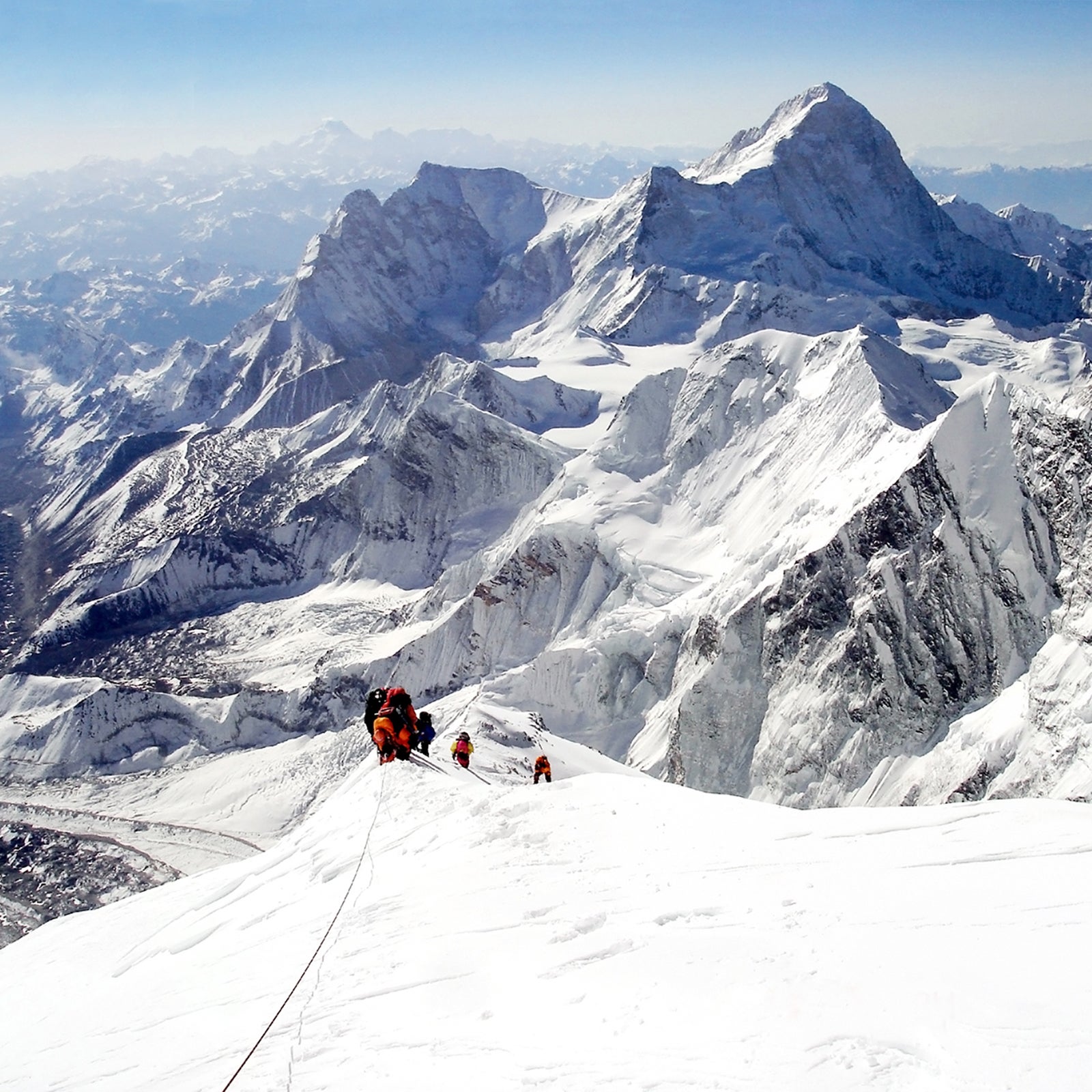It’s Everest season, which means that people from all over the world have gathered in Nepal and Tibet to make their attempt on the 29,035-foot peak. Some have trained for months, and others have spent decades gaining experience and preparing for this day.
When I was training for Mount Everest in the early 2000s, I was told, “Alan, you’d better be in the best shape of your life!” Well, they almost got it right. I not only needed to be in the best shape of my life, I needed to be in Everest shape.
My personal experiences with Everest have been difficult. I had a lung infection that stopped one climb, my body simply refused to acclimatize above 23,000 feet on another, and I gave up mentally on my third. Many Everest climbers have full-time jobs and families and don’t have the time to get into professional shape, which would take hours of training every day. It becomes critical to make every workout count without hurting yourself. For my fourth attempt—and first successful summit—on Everest, my training mantra became: when you think you have given it your all, you have just begun.
If you ask 100 Everest climbers, you’ll get 101 different answers on the best way to train, and I don’t think there is one perfect approach. Some climbers will say cycling for five to eight hours in the middle of the night is best, others prefer swimming or weight training. And age does play a role. With the clear disclaimer that I am not a doctor and everyone should visit their own physician before entering any kind of Everest training program, here are the three key lessons I learned along the way about getting into Everest shape.
Commitment
Just like marathon runners who hit the wall, Everest climbers usually hit their wall between 26,000 and 28,000 feet, in the dead of night, with temperatures well below zero, and probably while fighting a stiff wind in their face. It’s brutal, and you have to know why you’re there, because it’s extremely easy to simply give up, turn around, and go home defeated.
Similarly, preparing for Everest requires a deep commitment and sacrifice. From my own experience and observation of many others over almost two decades, the best training programs don’t involve pushing yourself to the limit each day, throwing up, and bragging about your mileage and vert. The best in class have thoughtful programs that emphasize balance.
The commitment during training is to remain disciplined over a long period of time. Training for Everest becomes a second job: getting up before dawn for a long run, spending weekends away from friends and family for long, stamina-building hikes, going to the gym after work three days a week for a couple hours of smart, intense work. Yes, it’s easy to skip a day, but you will just undermine your own goals and pay dearly for it later.
Mental Toughness
Mental toughness is crucial to having a positive Everest experience. I don’t only mean the ability to push yourself physically but also the ability to manage your emotions and practice extreme patience. Train in harsh conditions: take a long run in cold rain or a big hike with huge elevation gain in cold winds. This helps condition not only the body but also the mind. You learn how to manage layers, gear, and techniques. You gain confidence that if the unexpected happens, you can handle it. You build toughness.
Visualization techniques are powerful. When I first started to climb big mountains, I had a fear of heights. So I decided a bungee jump in New Zealand would cure me. While tramping on the beautiful South Island, I visualized jumping off the old bridge over the Kawarau River. My palms became sweaty and my heart raced as I saw myself falling toward the cold rushing waters below. But each time I visualized it, the easier it became. When the time came, I did an elegant swan dive and had the time of my life. I was never afraid of heights again.
Visualize being on Everest. Think through each part of the climb and where you will be stressed. It might be in the Khumbu Icefall or on the Second Step. Walk through it in your mind. If you can get in some incredibly long days—think 16 hours of constant, tough physical activity—it will be money in the bank for you later on. However, remember that just when you think you have given it your all in training, you have just started if you want to summit Everest.
Physical Balance
If you look at the world’s best climbers, they would not win a bodybuilding contest. Usually, they are tall and lanky, not muscle-bound specimens with Popeye forearms. I promise you that spending five hours a day throwing a medical ball against the wall will not do, just like running ten miles a day won’t either.
Climbing any mountain like Everest is an exercise in patience and stamina. The best training programs emphasize long, steady workouts that keep your heart rate in zone two. For a 40-year-old, that would be a heart rate in the range of 126 to 144 beats per minute, or about 70 percent to 80 percent of their maximum heart rate. (This calculation varies greatly depending on the individual, so consult a professional to determine your own.)
It’s key have have a solid core and legs for an Everest climb. Two of the strongest muscle groups in the human body are the quadriceps and gluteus (buttocks). The gluteus is the largest muscle group, so building it up with exercises like squats, leg presses, stair climbing, and lunges, and learning how to engage it are important to surviving long days at altitude. Also, don’t forget the poor calves; they seem to always get ignored, and you will regret not including them when you’re hurting at 24,000 feet on the Lhotse Face!
The upper body plays a role when carrying a big pack, but most Everest climbers never carry more than 20 to 30 pounds. Building the muscles in the shoulder group will pay back dividends, especially if you carry a lot of your own gear.
Finally, if there’s one word that sums up a solid training program for Everest, it’s cardio. Due to reduced air pressure, the oxygen thins out on Everest. At Base Camp, there’s about 50 percent of the available oxygen molecules compared to sea level. On the summit, that drops to a staggering 33 percent. Even using supplemental oxygen only makes a 3,000-foot difference—so at 27,000 feet, the body feels like it’s at 24,000 feet. Both an efficient cardio engine and a slow, smart acclimatization program are critical.
There are many ways to build strong hearts and lungs. Aerobic exercises like running, swimming, and cycling are great; however, as the saying goes: train for your sport by doing your sport. Thus, the best way to build cardio for hiking and climbing is to hike and climb. Consistent long days (at least eight hours) will build a strong base, then fine-tune it with cardio-specific exercise at home or in the gym.
Training Programs
There are many training programs to prepare for Everest, but I’ve found the ones from to work well. Scott Johnston and Steve House teamed up to create a series of programs that can be customized. I’ve used them myself with good success.
It’s easy to make training for Everest too complex. You can overload yourself with metrics. The professional or highly dedicated athlete might evaluate their VO2 max, which is the maximum rate your body can move and use oxygen during periods of high stress or need. With treadmill and blood tests, a qualified doctor or trainer can measure this, as well as anaerobic threshold and lactate threshold, the latter of which which is when chemical lactate acid begins to build in your bloodstream and muscles, thus preventing the body from functioning at full capacity.
These measures and tests can help determine how well your body will be able to get oxygenated red blood cells to your muscles at high altitude. The body goes through an impressive series of physiological changes to adapt to the limited oxygen on Everest. The watery part of our blood (plasma) decreases to increase the density of the red blood cells, which makes our blood thicker and harder for the heart to pump. The heart pumps faster, we breathe harder to compensate, and over time, the body produces more red blood cells. By climbing higher than the previous day then returning to a lower altitude, your body creates more of these red blood cells.
Make training for Everest as much fun as climbing Everest. Set realistic goals, give yourself plenty of time, and get a partner to keep each other committed. Taking a full year to get in Everest shape is a realistic time frame. Doing a series of climbs on peaks like Aconcagua, Denali, and preferably an 8,000-meter peak like or will also give you the experience and confidence to attempt Everest.


